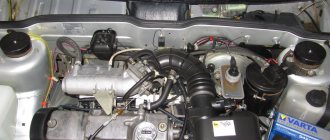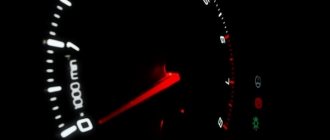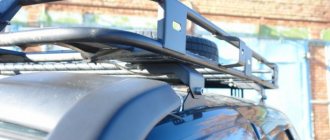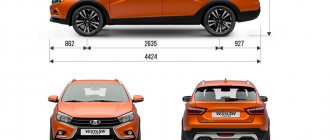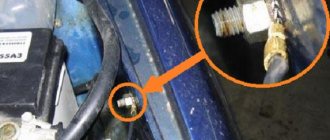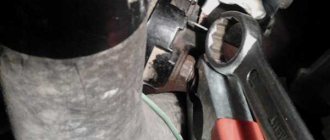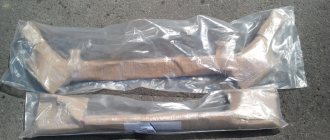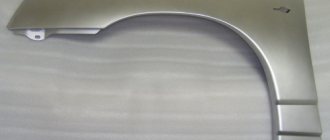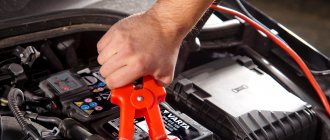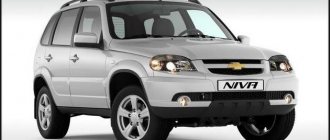cars
12.08.2018
no comments
94245
In order to confidently drive a car, you need to feel its dimensions. Its dimensions mean the main dimensions: length, width and height. But knowing specific measurements is not enough; it is important, while inside the car, to understand the real distances from the vehicle body to external obstacles.
We will tell you how to feel the car and learn how to drive through even the narrowest places. After all, all vehicles differ in their size, so even if an experienced driver gets behind the wheel of a new vehicle, he will need time to determine the size of the car. Not to mention beginners who find it difficult to understand their place on the road.
Let's try to figure out how to feel a car, what main problems inexperienced drivers face, and how to develop a spatial orientation scheme.
How to understand the dimensions of a car - beginner mistakes
The problem of car feel is especially acute for drivers without experience. Beginners who have recently received a driver's license complain: they don't feel the size of the car. In the first year of their practice, motorists are faced with problems of parking and maneuvering in narrow areas: it is difficult for them to turn around in a small area, in limited conditions, among many other obstacles.
When I got behind the wheel for the first time, it seemed to me that I was sitting in the center, and to the right and left of me there was the same distance to the wheels. Until now, after 10 years of driving experience, probably, like many drivers, I feel better the left dimensions - along the driver's seat.
As you can see, first of all you should understand that there is a greater distance to the right wheel than to the left.
The second mistake beginners make is trying to see what is in front of the bumper, looking over the hood. For this reason, many novice drivers move the driver's seat closer to the windshield, resting against the steering wheel. Should not be doing that. The driver needs to look at the road, and not at the wheels. You will be able to feel the size of the car when you gain sufficient skill.
And one more piece of advice – the main thing is to learn how to use mirrors. In the mirror, it seems that neighboring cars are further away than in reality. You think that the car behind you is still far away, since it looks quite small in the mirror, but in reality it is just an optical illusion.
IT IS IMPORTANT TO KNOW. Side and rearview mirrors have a blind spot
A car's blind spot is the space around the car that is not reflected in the mirrors. The driver may not be able to see oncoming vehicles from his seat. Therefore, it is worth remembering that before starting a maneuver, you need to first look in the mirrors several times, making sure that it is safe.
Individual car preparation
The adequacy of driving will depend on how comfortable, and most importantly, how correctly the driver sits behind the wheel. Proper seating reduces unnecessary driver movements and speeds up the decision-making process. This is achieved due to the fact that the driver has the correct position of his arms and legs, and in addition, sufficient visibility, without unnecessary bending and peeking. To achieve the optimal fit, the driver needs to make a special adjustment. Adjusting the driver's seat and steering wheel
This will allow you to feel as comfortable as possible while riding and not be distracted by numb arms, legs or back. If you feel discomfort after a short trip, try making the changes again.
Adjusting rear view mirrors
Beginners quite often underestimate the importance of mirrors and try to make parking or other maneuvers almost at random. By doing this, they risk damaging their or someone else's car. Adjusting mirrors to suit yourself is not at all difficult.
Change lane training
How to learn how to putty car body parts with your own hands.
Repeating the “parking in a confined space” exercise will help you figure out how to feel the dimensions of the car. Plastic tall objects come to the rescue. On an empty site, they imitate the lines of the curb and the dimensions of standing cars, between which you will have to squeeze. The best option, of course, is to actually drive into a courtyard or parking lot near a hypermarket. But for beginners it is better to practice in desert places first.
For example, let's take the Tiida Nissan model. The dimensions of the car are the same as those of most popular sedans. It is not recommended to choose smaller vehicles for training. The selected one goes to all classic garages, helping in the future to quickly evaluate sufficient quantities from the car's interior.
Training should be carried out at different times of the day. At night, distances begin to be perceived differently due to the headlights. On a bright day, fewer accidents occur, according to statistics. Even professionals make mistakes due to fatigue or after a hectic evening. Similarly, it is worth training constantly so as not to waste money on expensive repairs in the future.
How to feel the dimensions of a car
How to learn to ride a motorcycle
Don't be lazy to spend time on practical exercises. And you can practice in the following way: we take light boxes and build from them something similar to a gate, after which we try to drive through them. You need to devote several hours to this exercise, and if you cope with this task easily, we complicate it, that is, we reduce the distance between the boxes and increase the speed.
Approximately the same principle can be used - using boxes we designate the space into which we will need to move.
You can learn to feel the dimensions of your car in other ways. We draw a line on the asphalt, and then try to drive up close to it, but at the same time you should not touch it with your wheels.
And if you see that you cannot complete this exercise, then you can return to the task with boxes again. Also remember, this exercise will need to be performed until you learn to correctly determine the distance between your vehicle and such a stop line. This task is intended not only for the front wheels, but also for the rear ones.
In addition to these, there are other equally effective exercises. We take chalk and draw lines from the front wheels of the car 7 - 8 meters in front of them. At the same time, try to keep them as parallel to each other as possible. Next, we sit behind the wheel of a car, look for some stationary object that is constantly in front of your eyes (a protrusion on the dashboard can be suitable as such an object), and connect this object with the line that we drew from the right wheel, then along In the same diagram we mark the position of the left wheel. Thanks to this exercise, we will be able to feel the dimensions of our car. We drive away from these lines a little back, then drive your wheels onto them again.
If you combine all the above exercises, then I think you will get used to the dimensions of your car very quickly.
In order to confidently drive a car, you need to feel its dimensions. Its dimensions mean the main dimensions: length, width and height
But knowing specific measurements is not enough; it is important, while inside the car, to understand the real distances from the vehicle body to external obstacles
We will tell you how to feel the car and learn how to drive through even the narrowest places. After all, all vehicles differ in their size, so even if an experienced driver gets behind the wheel of a new vehicle, he will need time to determine the size of the car. Not to mention beginners who find it difficult to understand their place on the road.
Let's try to figure out how to feel a car, what main problems inexperienced drivers face, and how to develop a spatial orientation scheme.
Exercises to bring the feeling of a car to automaticity
There is a fairly wide variety of training options for inexperienced drivers, which allow you to quickly feel the dimensions of the car. We want to introduce you to the most effective ones.
Beacons
This is the simplest, but no less useful way to feel the dimensions. For this method we will need the following items that are absolutely safe for the car:
- Cones of any bright color.
- Plastic bottles filled with sand. For better visibility, you can stick bright flags into the bottles.
- Sacks or cardboard boxes filled with something very soft.
- Old tires.
The next step will be to install these beacons. Now you can start working directly.
- The driver must stop his car so that his front bumper, first the central part, and then the sides, touches the installed beacon. It is important to touch, and not knock over or not reach - this happens about the tenth or fifteenth time.
- Then you need to practice the same exercise with the rear bumper. These exercises should be brought to automaticity.
- After completing the first two stages, you need to move on. We mark with beacons the contours of two cars with a distance of 9 - 10 meters. Next, we begin to practice the parallel parking method, which is considered quite difficult.
- We put tall sticks in bottles with sand that will imitate gates and begin to work out the passage. First, the distance between the bottles should be approximately equal to the width of your car + 1 meter. Then we gradually narrow the distance, reducing it by 10 cm each time. The exercise will be considered completed if you can drive the car into a gap that exceeds the dimensions of the vehicle by only 10 cm.
Hitting
To complete this exercise we will need several empty plastic bottles. They are very susceptible to deformation and at the same time emit a very loud sound, which is almost impossible not to hear. We place the bottle on the road and try to run over it first with one wheel, and after achieving stable success - with the other. The exercise only seems simple, but without a good sense of the dimensions of the car it is almost impossible to do it. Gradually this task can be made more difficult. First we try to do the same thing, but at a higher speed. It is important here not to exceed 60 km/h, as you may end up in an emergency. The most difficult option for such training would be to run the tire into an object while simultaneously performing a turning maneuver. Not all drivers with extensive experience cope with this task on the first try.
Tags
A fairly common way to learn to feel the dimensions of a vehicle is the method of setting marks. Most often it is used by women. This can be done in several ways, but the simplest, in our opinion, is the following option. We will need a large ruler. We apply it to the hood at the level of the center of the front wheel. The second end should rest against the windshield, and a mark should be placed at the intersection. This can be done with a marker, a small colored sticker or adhesive tape. Then you need to do the same action with the second front wheel. These marks will help you drive the car for the first time and perform better in other training sessions.
Parts of the car can also become reference points for the driver; for example, many novice drivers can see deflectors on the hood; they very well indicate the leading edge of the hood. Manufacturer-installed bumps above the headlights can be a big help. Things are somewhat more complicated with installing tags at the rear of the car. Drivers of crossovers or hatchbacks quite often focus on the rear windshield wiper. Drivers of sedans can try installing an antenna on the very edge, which, however, is not always convenient.
Today, many vehicles are equipped, even in the basic version, with various systems aimed at helping the driver, but they also need to get used to. Such systems can be installed independently. The simplest option includes sensors that warn of approaching obstacles with sound or color indication. In expensive versions, you can find rear view cameras with a grid to determine the distance to an obstacle. The presence of all such devices does not mean that you do not need to learn to feel the dimensions of a car. This feeling gives you a feeling of confidence and pleasure from the trip. Take the time to do the exercises using all your electronics.
If you just got your license or bought a new car, don't neglect additional training and wait for the first incident. Pay as much attention as possible to your classes and soon you and your car will become one.
Learning to drive well does not only mean learning how to start a car and drive on busy roads. Each driver constantly has to perform such maneuvers as parking, turning on a narrow road, avoiding potholes and other obstacles. To accurately perform all these actions, you need a very good sense of the dimensions of your own car. With experience, this feeling comes naturally, but if you are a novice car enthusiast, it won’t hurt you to learn a little about this skill. There are several exercises specifically for this that will help develop a sense of the car’s dimensions.
Mistakes of novice drivers.
When driving a car for the first time, many people underestimate the importance of the vehicle’s dimensions. We are talking about the length and width of its body, as well as the height of the suspension. Naturally, for each car model these parameters may even differ greatly. At the same time, even knowing specific numbers does not always help with parking. To do this, you still need to get used to the car and literally feel it.
Very often, novice drivers overestimate their strength and think that they will be able to drive the car into the garage the first time or successfully avoid a dangerous hole on the road. But in reality, not everything is so simple, and when you get behind the wheel of a particular car, you should understand that driving skill and a sense of size will only come with time.
You can learn this by doing certain exercises, which we will definitely introduce you to. But before that, we want to introduce you to some mistakes that inexperienced drivers often make:
1.
While driving, the driver constantly tries to see what is happening directly under the front bumper of his car. However, if you look directly at the road in front of the car, you risk losing your straight line and colliding with other cars. While driving, you need to look only in front of you.
2.
When parking backwards, many beginners greatly underestimate the importance of rear-view mirrors and try to complete this task literally at random. However, in order to park without damaging the car body, it is very important to adjust the outside mirrors so that you can see the rear wheels of the car. Thanks to this, it will be possible to determine the distance to other objects as accurately as possible.
3.
Properly adjusted side mirrors will also help you change lanes without problems. Under no circumstances should you take the risk of literally cutting off other cars in an attempt to overtake them. You can occupy a lane while overtaking only after you have a full view of the entire car you are trying to overtake in the rearview mirror.
For the rest, the rules of the road and, of course, increased driving practice will help you. You can set it up on any abandoned road or parking lot where there are no other cars, and you will be able to drive around to your heart's content and train your sense of the dimensions of your car. To do this, we recommend performing the exercises described below.
Exercise "Beacons".
Preparing for this exercise is very simple. To do this, you need to make the beacons themselves, for which we take an ordinary plastic bottle and pour sand into it so that it becomes stable and does not fall even from the wind. After this, we insert a thin and maximally long pole into the bottle, marked on top with some bright flag or other markings. It is better to make several such devices for training.
We install beacons in front of our car and try to drive up to them close enough to lightly touch the flag with our bumper. In this case, the beacon should remain standing. If he falls, you can consider the exercise failed.
But you shouldn’t end the lesson here, since you still need to train your sense of the dimensions of the rear bumper. The same beacons will help you learn how to drive through narrow places as accurately as possible. To do this, just try to drive between two beacons. At the same time, at the very beginning of the exercise, the beacons can be installed quite far from each other. When you begin to succeed in performing this exercise, you need to gradually complicate the task for yourself, moving the beacons closer and closer. The same beacons can be used to perform figure eight and snake exercises.
While driving, it is very important to try to drive as close to the poppies as possible, while trying not to hit them.
Exercise "Hit."
This exercise will help you develop a sense of the lines of the wheels. Again, you will need available materials as inventory - an ordinary empty bottle or a small cardboard box. Place such beacons in front of the car and try to hit them as accurately as possible with either the right or left wheel of the car.
You can complicate the task if you place two beacons at a short distance from each other and try to drive through first one, and then through the other. You can also try passing them between the wheels of the car.
The highest level of driving can be achieved if you learn to perform the same exercises when driving in reverse. Even if everything starts to work out for you quickly, do not be lazy to consolidate your success in a few more days.
Exercise "Tags".
The best way for novice drivers to feel the dimensions of a car is to use the “Marks” exercise. It consists in the fact that special marks are applied to the base of the windshield, allowing you to feel and understand the location of the front wheels. To apply these marks to glass, you must:
1.
Take the longest ruler or just a straight bar.
2.
Place it on the hood so that it is located directly in the center of the front wheel of the car.
3.
Bring the second end of the ruler to the windshield, thus marking the line of the middle of the front wheel and make a corresponding mark on the glass (it is better to apply it from the inside so that it does not wash away).
4.
We perform similar actions with the second front wheel of the car.
In the future, in unusual situations, you will be able to focus on these marks, which will help you understand which line the front wheels of the car will follow while driving. These markers will be especially useful if you need to drive through a narrow arch, gate, or overcome a very narrow country road.
It is worth noting that very often such marks, which improve and develop the driver’s sense of the car’s dimensions, are installed by the manufacturers themselves. We are talking about hood deflectors, as well as special bulges in place of the front ones. Performing a decorative function, they simultaneously tell the driver how best to drive through a particular area. As markers for developing a sense of the rear dimensions of the car, instructors recommend focusing on (if there is one) or simply using rear-view mirrors for this. Otherwise, only exercises with beacons will help.
Rapid learning – can it be effective?
Exercises to sense the dimensions of a car can only be effective if they are performed frequently and regularly. If you have just received a driver's license and do not feel very confident on the road, you need to perform such training 1-2 times a week. Moreover, this needs to be done for about 1 year so that the acquired skills become professional and are performed automatically.
It is very important to understand that if you change your car, you will have to go through the whole science again.
Naturally, getting used to a new car will be much easier and faster, but you should not neglect the importance of exercises to sense the dimensions.
But there is another quick learning option that will help you become a real Schumacher. Almost every driving school has special extreme driving courses, after completing which you will feel the body and dimensions of your car like your own body. At the same time, the instructor accompanying you will tell you a lot of useful information on how to behave correctly in difficult situations on the road and avoid accidents.
All novice drivers are concerned with the question of how to learn to feel the dimensions of a car. When parking, by the way, this issue is especially acute. The feeling of the car and its dimensions is one of the most important skills for correct and safe movement. Nobody wants to accidentally hit someone else's vehicle and cost a pretty penny.
The current training in some driving schools leaves much to be desired. Since there, students are simply trained to successfully pass the exam, so as not to spoil their rating. At the same time, instructors overlook the lack of many practical skills among trainees that are necessary in real conditions on the road. And if it so happens that you studied at just such a driving school, then do not despair. You can master the skills yourself. This will require patience and training.
How to feel the dimensions of a car when entering a garage
Latest reviews from Kia Rio car owners
A very difficult task for a beginner is entering a garage. Therefore, in order to feel the dimensions of the car, you must initially enter backwards, guided by the side mirrors, so you will feel the side dimensions.
When you learn to feel the side dimensions, you can drive into the garage from the front. But now you need to feel the distance from the front bumper to the wall. There is a trick for this. It is necessary to tie a rubber ball to the ceiling on a rope, when entering the garage and touching the ball to the windshield, this will be a signal to you that you have driven in as expected.
Rear view mirrors help control the distance between a wall or other object and the rear edge of the car. It is necessary that they are configured correctly. Ideally, you need to see the rear wheels in the mirrors in order to navigate by them.
Be sure to look in your side mirrors when you need to change lanes. Look in the side mirror, if the neighboring car fits completely, then you can change lanes, but if at least part of the car is not noticeable, then when adjusting you can hit it.
Electronic assistants such as parking sensors and a camera will help you navigate and feel the dimensions of the car much faster.
Tags
To better feel the dimensions of the vehicle, it is worth making marks on the base of the windshield. Take a large straight ruler and place it on the hood where the center of the front wheel is. Attach the other end. In the place that will be on the axis specified by the wheel, apply a mark inside - a line with a marker or a small sticker. Do the same with the second front wheel of the car.
Markers help you better feel the dimensions of the car and choose the right direction of movement in any situation. Their application will allow you to get rid of problems associated with passage in narrow places, for example, arches, gates and other architectural forms. The marks will also help you feel the dimensions of the car and the width of its track when driving on a bad road.
Parts of the car body can also serve as a guide, which will help a beginner to feel the dimensions of the car. Many novice drivers install deflectors on the hood, popularly called “fly swatters”, precisely so that they can see the leading edge of the car. Some cars are equipped with special bulges on the headlights, for example, Nissan Micra, Ford Fiesta and others. They are designed specifically to improve the driver’s sense of size. Mirrors can serve as side markers, which will make it very easy to navigate.
With the rear clearance, the situation is much more complicated - learning to feel it is very difficult. Drivers of hatchbacks can use the rear windshield wiper as a guide, but owners of sedans will have it much worse. The ideal option for getting a perfect sense of taillights is the above exercise with beacons - repeating it regularly, you will be able to achieve excellent maneuvering in any circumstances.
How to learn to feel a car
A few simple exercises will help you learn how to feel the dimensions of a car. Novice drivers should practice spatial orientation skills on a closed race track. It is for this purpose that instructors separate small areas with flags and force students to drive into a conditional box. We suggest watching a video about how to learn to sense dimensions, and then complete several lessons.
To get a consultation
Lesson 1. Visualization
Mentally draw the position of your car relative to the walls of the box, get out of the vehicle and compare the picture presented with the real one. As a rule, it seems to beginners that the edges of the car are much closer to the walls of a conventional garage than they actually are.
Lesson 2. Beacons
Install an antenna at the extreme point of the hood; it will help you understand where the car body ends. At any time you can stop the car, get out of the car and see how close the obstacle is. After this, it will become clear how to do it correctly in a car, how to evaluate the distance and your own dimensions.
Lesson 3. Marking lines
If you are a beginner, to get a feel for the car, mark six lines on the asphalt with chalk or spray paint that:
- cross the front and rear wheels;
- continue the left and right axes;
- outline the rear and front bumpers.
The intersection points of the wheels with the front dashboard can be marked with colored paper or tape on the windshield. The marks will give an idea of the expected trajectory of movement. Thus, you will learn to determine the place on the road along which the car’s wheels will pass. Over time, the tags will no longer be needed; a chain of reactions will be developed in the brain.
Similarly, you can mark the intersection lines of the front and rear bumpers, front and rear wheels. The markings will make it easier to determine and feel the size and trajectory of the car.
Lesson 4. Getting hit by wheels
Place a small piece of cardboard on the road and deliberately try to run over it with each wheel in turn. This exercise will help you develop your sense of wheel line. Practice not only moving forward, but also reversing.
Lesson 5. Snake
Place barriers on the roadway and try to go around the obstacles without hitting them. Lighthouses can be marked with flags, cones, or ordinary plastic bottles.
Try to drive as close to the beacons as possible. Start with simple exercises, and over time make the tasks more difficult for yourself: place the flags closer together and try to guide the car closely between obstacles; "eight" and "snake".
The main advice on how to get used to the dimensions of the car is to practice as much as possible. You can also watch the video, which will help you get acquainted more clearly https://www.youtube.com/watch?v=l4EiBC8tgP8. Ask an experienced driver or instructor for additional training with you on the site.
Skills are acquired through driving. You will learn to intuitively sense the correct distance to obstacles with high accuracy. With experience, you will understand how to navigate the mirrors in the car, how to feel the car.
To get a consultation
The power of training
Experts have come up with special training exercises for those who have just started driving. You can practice both on special sites and in some clearing (after making sure that the maneuvers being performed are safe, of course):
- Beacon. One of the easiest ways to determine the dimensions of a car. Often cones, containers of water, sandbags, and old wheels act as a beacon. The main task is not to knock down the beacon while moving.
- Hit. To implement this exercise, you will need an empty bottle, which you need to run over with your front wheel. The exercise seems quite simple, but novice drivers often miss.
- Tags. At first, many car enthusiasts leave marks on the front window for the sensitivity of the car.
A ruler or large meter should be placed on the hood where the center of the drive wheel is located. The end of the meter should be leaned against the windshield. Place a mark at the location of the rear wheel axle. Accordingly, before the front one, repeat a similar action.
The marks will help when parking, entering the garage and in other places.
Why is it important to feel the dimensions?
A sense of size comes with experience. This skill will come in handy:
- When parking. In order not to hit other cars and curbs, you need to feel the size of the vehicle.
- In traffic jams, because you have to drive slowly behind the car in front and keep a certain distance.
- When driving in a busy part of the city, the driver will have no problem passing someone on a narrow road.
- In the forest and in rural areas, a sense of the size of the vehicle is also useful, since you will often have to drive between a pond or other obstacle.
Many driving schools give the only very practical advice - practice. You first need to practice in a driving school or in a free area, driving around conditional obstacles, such as chips. Each successful completion of the exercise will bring you closer to the ideal feeling of the car.
If the car model changes in the future, the same exercises can be applied. You will have to relearn a little for the new sizes, but this will be easier.
What mistakes do novice drivers make?
Look at the road under the wheels. Often, in this way, the driver may lose sight of other objects on the sides. Look only in the side mirror
Only part of the car will be visible in it; you need to pay attention to it when changing lanes. Do not take into account the dimensions of the bumper. When driving, you need to estimate the distance from the hood to another car or curb.
A novice car enthusiast should first of all adjust the mirrors, but they are only an auxiliary tool.
Find out how to do this correctly in this video:
How to feel the length of the hood
In order to feel the length of the hood you need to:
- Adjust the seat so that the length of the bumper is as visible as possible.
- You can install a car sign on the edge of the hood.
The backward movement should be realized slowly. The driver levels the car by looking in the left and right mirrors. You can install a parking sensor in the rear bumper, which will greatly simplify reversing. However, you will have to spend money on this option.
General methods for feeling dimensions are connected by one thing - practice. You need to choose a road with turns, and drive along the highway more often. You can train in a free parking lot by installing bottles for boundaries.
If in doubt, it is better to get out and assess how close the obstacle is. It’s better to spend extra seconds than to later pay for the repair of someone else’s or your car.
If after self-training you still don’t have confidence, it’s better to go to a driving school and take extra hours. When studying, you can take more practice in advance, since it will be cheaper than buying time separately. An experienced driver already intuitively senses the size of the car, so don’t worry if you’re not good at it at the very beginning.
You can find some more exercises here:
Problems with perception
The dimensions of trucks are not easy to understand even for experienced drivers. But there are some tricks that allow both beginners and long-distance drivers to perceive the distances to neighboring cars in more detail. To assess the reach of the hood, extend it as far as possible towards the steering wheel. But there are cars where even in this position the nose of the car is not visible. This is where decorative elements on the hood come to the rescue: flags, an antenna, a figurine.
When modernizing a car, they try to install decorative elements on the very edge of the hood. After this innovation, there will be no problems with parking in front. Rearward maneuvers are made easier by fortunately their cost is already low. Models from China will cost several hundred rubles, installation is simple, and you can do it yourself or give the service half of the cost of the gadget for installation.
To improve visibility, many drivers stick convex round mirrors on top of the standard ones. Replace the mirror in the cabin with a viewing one. They install a similar one above the trunk glass in station wagons and minivans. You can use a rear view camera if technically possible.
An easy way to park safely is to have a friend help you. The passenger can get out and manage the process.
Dimensions: why feel them correctly
Dimensions refer to the length, width and height of the car. They are different for different models; you can find them in the instruction manual. Knowing the dimensions, you will be able to park and maneuver on city streets without any problems. The feeling of your own car will help you easily park in a small area, or move over rough terrain with trees or other obstacles. This also needs to be taken into account when purchasing a garage.
The feeling of size comes only after some time as a result of regular trips. It is also worth listening to practical advice that will help you do this a little faster.
Action plan
The first rule of an experienced driver: “If you have doubts due to lack of visibility or due to poor visibility, poor condition, then you need to stop and not be lazy to go outside and look.” Intuitively, while driving, the desire often comes to wait a few seconds and check what is overboard.
This rule must always be followed during any type of maneuver. This way, the highest level of aerobatics is achieved, the safety of your car and the health of passengers. Even when driving through a green light right away, you should once again make sure that traffic is safe by turning your head left and right. So when parking, you should constantly monitor three viewpoints at once. At any second, a restless baby could sit under your bumper in the yard.
In order to park confidently, change lanes and successfully avoid various obstacles on the road, you need to be well oriented in space, feeling the dimensions of your car. This skill comes with experience, but there are some exercises and ways to speed up the “process of getting used to” the car a little. They will be useful for both beginners and experienced drivers who have switched to a new vehicle.
Some drivers manage to learn to feel the dimensions of new cars in the shortest possible time. Others, even those who have driving experience in a particular car, are not always able to confidently estimate distances when driving. Only constant training and regular driving practice will help you get used to the dimensions of any car.
The rapidly increasing pace of life of modern man has naturally led to the fact that the number of cars on modern roads is increasing every day. Every day only new drivers take them out. Your own car is an indispensable assistant, an extremely comfortable and maneuverable means of transportation that allows you to solve many problems.
Moving around the city very often occurs along narrow streets or in dense traffic. High traffic density in a limited space naturally forces drivers to organically feel the dimensions of cars in order to eliminate the possibility of an accident. This is especially necessary for an inexperienced driver who finds it difficult to quickly navigate a traffic situation.
Why is this happening
The first thing to do is evaluate the dimensions of the car when purchasing it. Some people will need an hour or two to figure out how to enter a parking lot or estimate the turning radius. Some people need months to develop confidence during the maneuver.
Perceived by sight through mirrors and glass. Refraction of real objects occurs. Therefore, it will take a lot of time to correctly assess the true distances to the rear bumper and the maximum nose reach of the car. With parking sensors and a camera, the task becomes much easier; the criterion of habit is no longer so important.
However, you should not completely trust the sensors. Often they “swallow” the signal and remain treacherously silent. And having gotten used to the dimensions of the car, a feeling of anxiety will arise in the wrong situation, when a pole or high curb is very close, and the parking sensors are completely calm and there are no objects.
Car feeling
To begin with, it is worth defining the concept of “car dimensions”. There are two independent values:
- static dimensions - front, rear and sides of the car.
- dynamic dimensions - most often you have to deal with them in practice. This is the distance to a certain point taking into account movement.
In order to correctly sense the dimensions of a car, even special courses are held in driving schools. However, you can learn this art on your own without spending money.
Hitting
The exercise is also very simple, but requires good practice to accurately repeat the results achieved. An empty plastic bottle is placed flat on the platform. Your task is to hit such an object alternately with the left and right front wheel. The exercise may seem incredibly simple, but the sense of size often fails novice drivers, which causes them to miss.
When the exercise is performed flawlessly, it is worth complicating its conditions - hitting it at a higher speed. To consolidate the result, select a deserted section of the road and drive it at a speed of 60 km/h - this will require a very good sense of dimensions. However, it is not recommended to exceed the specified threshold - you may end up in a dangerous situation.
With due diligence, a beginner will quickly learn to feel the dimensions of a car.
In order to perfectly feel the dimensions of the car, you should move on to the third stage - you should hit the bottle while simultaneously making a turn. Even experienced drivers make mistakes in such an exercise; due to its complexity, it turns out to be the most effective. The plastic bottle can be replaced with another object, but it should be easily deformed, make a loud sound, but not fly out from under the wheel at high speed. A good substitute for such a beacon for training your sense of size is a cardboard box folded several times.
Why learn to feel the dimensions of a car?
The feeling of your car is necessary for safe driving. A correct understanding of the size of a car will help you park deftly, change lanes, overtake vehicles in front, move in traffic and avoid obstacles.
There are two types of dimensions:
- static;
- dynamic.
Static
– these are the main parameters of the car, its dimensions.
Dynamic
– this is the actual distance from the edge of the body to the conditional obstacle, which is determined in the direction of movement. The driver, as he approaches the actual point, calculates the approximate distance to it. The distance is determined in dynamite - in motion.
It is spatial orientation that will help the driver not to hit curbs and other vehicles. If you brake in time before an obstacle, you can avoid a collision. And an erroneous assessment of the distance leads not only to scratches and other damage to the car’s paintwork, but also to more serious consequences: accidents and dents.
To feel the dimensions, you need to develop a special skill. You can purchase it during driving practice, or work it out specifically. The skill will be useful in various situations:
- in a parking lot - it will help you drive into a narrow space without hitting abandoned cars with your bumper or fender;
- on the road - when changing lanes, estimate the distance to neighboring cars, while maintaining distance in traffic jams, when passing vehicles on narrow sections of the roadway, when giving priority to crossings;
- when entering the garage, the feeling of the car’s own size will tell you when it is necessary to stop the car so that you can close the gate and calmly get out of the car.
To get a consultation
Mastering the pedals
A simple exercise will help you get used to the gas pedal, during which the driver’s right foot, after starting the engine, smoothly presses the gas, while controlling the progress of the tachometer needle, which first approaches the 2000 rpm mark and then moves further. When the 5000 mark is reached, the driver should smoothly release the gas, lightly holding the pedal at every thousand revolutions and remembering the sound of the engine running. Well-trained this skill will help to polish the traction control of a new car, when the driver can reach a given number of revolutions (with an error of 300-500 rpm) by the sound of the engine. A you feel the clutch of a new car , during which you need to squeeze the pedal several times without engage the gear in order to remember the force required by the leg to overcome the resistance of the return mechanism spring. Only after this movement has been worked out to the point of automaticity, will it be possible to move on to the second part of the exercise, in which the driver depresses the clutch and, having started moving in first gear, immediately depresses the clutch again and smoothly brakes. Several repetitions will help you understand what position of the pedal leads to the clutch “grabbing” and the car starting to move, as well as whether the car needs a boost of gas for this or idling is enough. Then the driver must allow the car to move away and go into second gear, then press the clutch pedal and brake smoothly. This exercise will allow the driver to better understand the car's reaction to his actions while driving.
Dimensions
The concept of dimensions usually refers to the height, length and width of the car. But the machine is not only in a static position; it also has dynamic dimensions. Those who have carefully studied in a driving school know that there are six main indicators:
- A straight line that continues the wheels – left and right.
- Continuation line of the front bumper.
- Rear bumper.
- Front axle.
- Rear axle.
These parameters are completely different for different brands and not only beginners, but also quite experienced drivers need to get used to them. You can feel them well only after some time has passed - this is the experience of traveling in this particular car. Only after feeling his car, the driver can easily fit into a dense traffic flow or park in a very small and inconvenient space. The same feeling allows you to avoid bumps on the road or move on rough terrain. It’s quite easy to spot a novice driving; many of them try to crane their necks during the trip and try to look at the road in front of the bumper. Such drivers can often see various minor damage to the bumper, front and rear, or headlights. All this is most often the result of unsuccessful parking. You can try to avoid this, because even minor repairs often cost a very tidy sum.
Feeling the dimensions of the car is the key to accident-free movement
Having received a driver's license and bought a car, it is worth driving for some time on not very busy roads and practicing parking in places where this action can be done as simply as possible. This must be done not only because you still have too little driving experience, but also because you need to get used to your new iron friend and feel the dimensions of the car. At this stage, many people wonder how to feel the dimensions of the car if I am a beginner. It is the sense of size that allows you to perform any maneuvers without violating your own and others’ safety.
Recommendations and tips: how to feel the dimensions of a car.
Vehicle dimensions
Inexperienced drivers are very easy to spot on the road; they crane their necks forward and try to look not only at their own bumper, but also at what is behind it. This makes it much more difficult to control the distance to another car.
If you find it difficult to cope with the distance, then do the following exercise.
Park in the back next to a parked car. It is advisable that it be a familiar car, and that someone watches this exercise from the side. Approach the car at various distances. Note for yourself where your hood is in relation to the car in front. For example, your hood half covers the rear bumper of the selected car. Go out and see what the distance between you really is. Remember that for sedans, hatchbacks, SUVs, this distance will be different, since the rear number plate can be fixed at different heights. Just experiment, drive closer, further and record the distance. Do the same exercise with the wall in case of this parking option.
When you are moving in reverse, it is even more difficult to feel the dimensions. You can do the above exercise. If you are a hatchback driver, then use the rear brush as a guide. And on a sedan, you will have to take into account, in addition to the distance between cars, the size of your own bumper.
As for parking in reverse, work out a certain pattern.
If you were not taught the rules in practical driving lessons, use the Internet. There are plenty of videos online that will help you practice parking until it becomes automatic. You can also take additional paid lessons to improve your driving skills. It is not very expensive, but the benefits of such targeted activities are enormous.
Determine the side dimensions by looking at the side rear view mirrors.
Try to navigate along the outermost part of the mirror. If, while the cars are actively moving, you need to change lanes, then first look at the car behind you in the side mirror. If you can completely see the car, you can change lanes. If only part of it is visible, it means that it is close to you, and when changing lanes you can catch it.
Exercises to learn to feel the dimensions of a car
Skills need to be constantly improved. It is recommended to do this using a traditional exercise called “snake”. To do this, you need to look for special traffic cones or “chips” between which you will have to maneuver. Don't forget that the front wheels have a larger turning radius than the rear wheels. During the first time you need to move at minimum speed. Then you need to gradually increase the speed, while not forgetting to reduce the gaps between the cones. In addition, you can feel the dimensions of the car using the figure eight exercise.
First, you need to practice moving on an oval, and then go through the entire exercise. It is important to take into account the fact that when driving in reverse, the car has better maneuverability. If you perform too sharp maneuvers, the trajectory of movement will change. Then you need to stop the car, find the main landmarks in the rear-view mirror, and continue the exercise.
Don't forget to learn how to feel the approximate braking distance of a car. To do this, you need to find a suitable flat section of the road and accelerate to the required speed, then sharply press the brake. This exercise should be performed on road sections where there are no other vehicles or pedestrians. Using chalk, you need to make a line on the road. You need to approach it at a minimum distance, but driving onto the line is prohibited. This is quite difficult to do, so instead of a line you can use cardboard boxes or plastic bottles.
With each new trip in your car, you will get used to its dimensions and feel more confident on the road. You just need to not be afraid to be road users and experience will accumulate, helping you cope with any maneuvers.
Share “How to learn to feel the dimensions of a car”
Fast learning
To develop a sense of the dimensions of a car, you should exercise at least 1–2 times a week during the first year of driving a car. Since the parameters of each vehicle are individual, classes should be repeated after purchasing a new car. In addition, there is always the option of undergoing vocational training at a specialized driving school. By enrolling in extreme driving courses, you will learn to feel the dimensions of the car in any situation, and also learn how to avoid the most dangerous situations on the road.
Driving in a straight line and making turns are not the only skills an experienced driver must have. In real conditions, very often you have to perform many other maneuvers, such as parking, avoiding obstacles, driving in reverse and many others. In order to perform these actions perfectly and correctly, you need to be able to sense the dimensions of the vehicle being driven. This skill is developed over time on its own, but there are special exercises that will help a novice car enthusiast navigate the road with ease.
Beginner mistakes
The dimensions of a car mean its linear dimensions, that is, the length, width of the body and the distance from the suspension to the ground. Novice drivers often cannot cope with parking or other maneuvers due to the fact that they cannot properly feel the car. It happens that a driver who is confident in his abilities simply cannot drive the vehicle into the garage, although he felt more than comfortable on the road. In such a situation, there is no need to be upset. You just need to understand that everything will come with time, and now you just need more time and concentration to overcome some obstacles. Let's look at the main mistakes made by beginners:
1. A look at the asphalt. This is a very common phenomenon when a driver tries to peer at the road under the front bumper of a car. In order not to lose orientation in space, you need to look strictly ahead of you.
2. Underrated mirrors. It’s rare that a novice driver pays due attention to adjusting the mirrors, but in vain - such manipulation can make parking easier.
3. Dangerous overtaking. This is one of the most serious mistakes when the driver does not pay attention to the external mirrors while overtaking, performing this maneuver literally at random. Before crossing the median, you must make sure that the car behind you is not trying to do the same.
Exercise "Lighthouse"
This simple exercise often comes to the aid of an inexperienced car enthusiast. First you need to build the necessary tools. Ordinary plastic bottles that need to be weighted, for example, with sand, are perfect for this. Next, a signaling beacon made of bright material is inserted into the bottle. That's all! The necessary equipment has been made, a few more pieces remain to be made, and you can proceed to the exercise.
The whole idea of the training is to get as close to the flags as possible without hitting the bottle. Flags can be placed in the form of a corridor or a zigzag. As you successfully overcome obstacles, the distance between the bottles can be reduced. The exercise is considered failed if at least one bottle is knocked over.
Exercise "travel"
By practicing this exercise, you can improve your sense of wheel line. Before you get behind the wheel and start, you need to prepare the appropriate equipment, the role of which will be played perfectly by empty bottles or small cardboard boxes. The purpose of the exercise is to drive the wheel exactly along the selected landmark. Inventory can be moved closer or further relative to each other. It all depends on the driver's skills. There is a variant of this exercise when you need to drive without hitting the box and bottle with the wheels, that is, so that the object ends up exactly between the wheels. This exercise is also perfect for honing your driving skills in reverse.
Marking
To make it easier to perceive the location of the front wheels, there is a method using certain signs. These marks are located at the bottom of the windshield. In order to perform such a manipulation, you need to take a straight rod of the required length (ideally it should be a long ruler). Next, the rack must be placed on the hood so that it aligns with the projection of the line intersecting the center of the wheel. The other end of the measuring tool is applied to the windshield and a mark is made using a marker. This operation is then repeated with another wheel.
Such markings will help you navigate in unusual situations and visually indicate the location of the wheels while driving through a gate or along a narrow road.
Some car models have factory markings that perform the same functions. These could be the same strokes on the windshield or special bulges on the front of the car body.
Such exercises will give the desired result only if repeated for a long time and repeatedly. If you feel less confident on a busy road or experience a lot of stress while parking, increase the amount of training you do. At a minimum, you need to do these exercises a couple of times every 7 days. If you fulfill all the requirements, then within a year the level of skill will increase significantly, and with it will come confidence.
Having received a driver's license, it is worth driving for some time on not very busy roads and practicing parking in places where this action can be done as simply as possible. This must be done not only because you still have too little driving experience, but also because you need to get used to your new iron friend and feel the dimensions of the car. At this stage, many people wonder how to feel the dimensions of the car if I am a beginner. It is the sense of size that allows you to do so without violating your own and others’ safety.
Recommendations and tips: how to feel the dimensions of a car.
